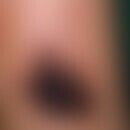Synonym(s)
HistoryThis section has been translated automatically.
DefinitionThis section has been translated automatically.
Frequent, solitary or multiple, acute or chronic, purulent infection of the superficial part of the hair follicle attached to the hair follicle, which is predominantly caused by staphylococci (commonly known as pimples or pustules). This type of folliculitis occurs mainly in warm and humid tropical zones.
You might also be interested in
EtiopathogenesisThis section has been translated automatically.
Infection of the hair follicle by Staphylococcus aureus.
Preconditions:
- Microtrauma, e.g. due to shaving (beard region and lower legs).
- Moist maceration, moist warm intertriginous areas, sweating, too greasy or too moist treatment of certain skin areas, plastic occlusive dressing
- Faulty occluding clothing in warm and humid climate
- Weakness of the immune system
- Itchy scratched skin diseases
ManifestationThis section has been translated automatically.
Occurrence possible at any age, but especially in infancy and toddlers. No gender dominance.
LocalizationThis section has been translated automatically.
Mainly face, cheeks, nose, armpits, extremities, lower legs after shaving. In principle possible on the entire integument, where occlusion occurs through clothing or through close contact.
Clinical featuresThis section has been translated automatically.
Acutely occurring, solitary or multiple, punctate (follicularly bound), also grouped, 0.1-0.2 cm, flat, red papules or yellow-red papulo-pustules with a discrete red fringe. The follicular inflammations are often pierced by a central hair. This finding is easily recognized when terminal hair follicles are involved (Note: only clear follicular involvement defines the diagnosis! If vellus hair regions are affected (e.g. trunk), the relation to the follicle is not always clear).
Superficial folliculitis does not cross the follicular boundary. There is no perifollicular abscess formation (furuncle).
There is slight painfulness of the individual florescence, possibly also of the region, but more frequently itching. After about 5 days, drying and formation of a yellow-brown crust. Complete healing without scarring. Recurrences are common if the triggering cause is not removed.
HistologyThis section has been translated automatically.
Follicularly bound, neutrophil infiltration of the superficial parts of the follicle.
Differential diagnosisThis section has been translated automatically.
Folliculitis barbae candidamycetica;
follicular trichophytia
Gram-negative folliculitis(whirlpool dermatitis)
Oil acne ( acne, oil acne)
folliculitis under treatment with tyrosine kinase inhibitors (see there).
External therapyThis section has been translated automatically.
Internal therapyThis section has been translated automatically.
Note(s)This section has been translated automatically.
Bacterial or non-bacterial folliculitis not induced by staphylococci are generally identified with the causative pathogen: demodex folliculitis, pityrosporum folliculitis, gram-negative folliculitis , etc.
LiteratureThis section has been translated automatically.
- Durdu M et al (2013) First step in the differential diagnosis of folliculitis: cytology. Crit Rev Microbiol 39:9-25
- Edlich RF et al (2005) Bacterial diseases of the skin. J Long Term Eff Med Implants 15:499-510
- Fourtillan E et al (2013) Treatment of superficial bacterial cutaneous infections: a survey among general practitioners in France. Ann Dermatol Venereol 140: 755-762
- LaBerge L et al (2012) Actinic superficial folliculitis in a 29-year-old man. J Cutan Med Surgery 16:191-193
- Kaimal S et al (2009) Dermatitis cruris pustulosa et atrophicans revisited: our experience with 37 patients in south India. Int J Dermatol 48:1082-1090
- Palit A et al (2010) Current concepts in the management of bacterial skin infections in children. Indian J Dermatol Venereol Leprol 76:476-488
Incoming links (14)
Boils; Folliculitis staphylogenes superficialis; Folliculitis (superficial folliculitis); Impetigo follicularis hard as a rock; Impetigo hard as a rock; Impetigo (overview); Lip furuncle; Ostiofolliculitis hard rock; Pimples; Pustular folliculitis; ... Show allOutgoing links (22)
Acne (overview); Boils; Candida folliculitis; Clioquinol; Clioquinol lotio 0.5-5%; Demodex folliculitis; Dicloxacillin; Exanthema, acneiformes; Folliculitis barbae; Folliculitis gramnegative; ... Show allDisclaimer
Please ask your physician for a reliable diagnosis. This website is only meant as a reference.











